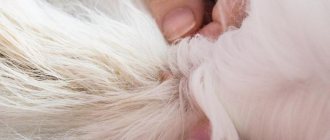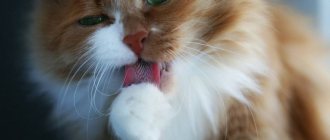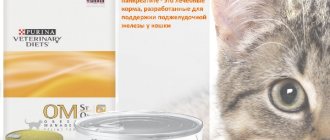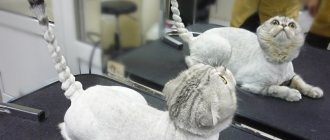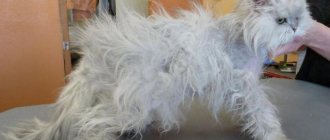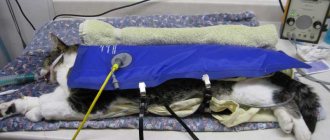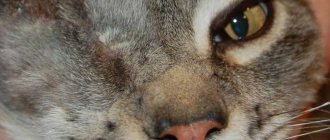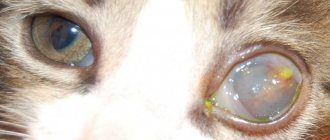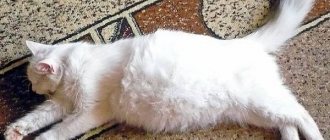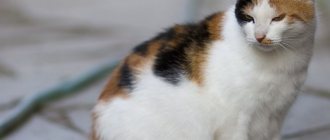What kind of discharge is considered normal in cats?
Under normal conditions, a cat's eyes do not run. A small amount of transparent liquid secretion is released from the organs of vision; it is barely noticeable. Watery eyes can appear from external irritants: harsh bright light, smoke, rising dust, caustic chemicals. After such factors, the production of tears quickly stops, and the eyes return to normal. You can often see wet eyelids in your pet after sleep.
© shutterstock
In all such cases, the discharge is not profuse, has no color and an unpleasant odor.
If your cat starts to have brown, cloudy, white or red discharge from his eyes, the cat most likely has an infection. But pathology is not always caused by harmful microorganisms.
Instructions for use of solutions
To ensure that the animal is not in pain and that the procedure is effective, you need to take a responsible approach to eye rinsing. To do this you need to adhere to the following rules:
- Ask someone for help . Have one participant wash the eyes while the other holds the animal tightly.
- Take a clean cotton swab . Wet it with solution, decoction or water.
- If your pet's eyelids are stuck together , first gently moisten them with the solution until they open.
- Blot sticky eyelashes with a damp swab in the direction from the nose to the corners of the eyes.
- Squeeze the liquid collected in the tampon into the cat's eye.
Tampons must be wet. Dry cotton wool can further injure the damaged eye. It is better to use warm solutions.
Please note that if your pet has black discharge in his eyes, there is no need to self-medicate. You may harm your cat's health. Contact your veterinarian immediately for a correct diagnosis and treatment.
Transparent liquid in the eyes may appear as a result of a reaction that protects the animal’s eyes from environmental factors (wind, dust). The same reaction can occur if an irritant gets into your pet’s nose. In Persian cats, lacrimation occurs after sleep. This is due to the structural features of their heads. That is, if the animal feels well and the fluid released from the eyes is clear, then the cat is healthy. If it has acquired a certain shade, then it’s time to start worrying.
Why do cats have brown discharge from their eyes?
Excessive lacrimation, clearly beyond the normal range, is called epiphora. The term is used in both medicine and veterinary medicine.
Depending on the disease, tears in cats can have different consistency and color. Brown discharge from the eyes of cats is caused by pigments that are part of tears during some infections and inflammatory processes. The discharged liquid may also have a reddish tint.
Bacterial infections cause suppuration and a white, yellow or greenish coating appears in the eye area.
The causes of epiphora in cats are divided into two main groups, let’s look at each.
Prevention of eye diseases in cats
Prevention of eye diseases consists of the following actions:
- do not smoke in the room where the pet lives, avoid using perfumes and household chemicals;
- use hypoallergenic ready-made comas of at least premium class;
- destroy ectoparasites and conduct quarterly deworming;
- Vaccinate your pet regularly according to the vaccination plan.
- cats predisposed to eye diseases are periodically instilled with prophylactic agents.
Be sure to read:
One of the cat's eyes is watering: reasons, what to do at home, medications and folk methods
Eye diseases or digestive disorders are caused by human food, so giving your pet a treat can result in illness.
Diseases and pathologies that cause disturbances in the outflow of tears from the eyes through the lacrimal ducts
This group includes:
- Narrowing of the tear ducts of an inflammatory nature.
- Stenosis of the lacrimal openings (too small tubules).
- A foreign object that has entered the lumen of the lacrimal canal.
- Eye injury, as a result of which the functioning of the lacrimal system was disrupted.
- Dacryocystitis (non-infectious inflammation of the lacrimal sac).
- Allergy.
- Tumors, neoplasms, compressing tubules.
© shutterstock
Treatment
If your pet shows signs of pathology, the best option is to take it to the veterinarian. However, this is not always possible, so you can do your own rinsing at home.
The procedure is carried out using an antiseptic solution that does not contain alcohol. This can be a decoction of chamomile or oak bark, or a solution of furatsilin. To perform the manipulation as efficiently and safely as possible, you should adhere to the recommendations presented below:
- Before and after the procedure, you must treat your hands with an antiseptic.
- It is better to carry out the manipulation together to securely fix the pet so that it does not harm either itself or the person.
- The eyes should be treated with gauze or a cosmetic swab that does not leave lint.
- The rinsing solution should be warm and weak.
- If the animal's eyelids or eyelashes are stuck together, you can briefly apply a well-moistened swab to this area.
- Treatment is carried out in the direction from the bridge of the nose to the outer corners.
- Along with the eyes, it is necessary to wipe the cheeks, nose and eyebrows.
How to wash a cat's eyes: video
Important! You should not delay home treatment if dark or black discharge does not go away after 1-2 days. A progressive disease can lead to blindness of the pet.
To treat pathological discharge, the veterinarian will prescribe treatment to eliminate the very cause of this phenomenon. It may be necessary to carry out diagnostics, including scraping from the cornea, a blood test and more complex examination methods (PCR reaction, ELISA, X-ray, etc.).
Depending on the pathology, the doctor will prescribe medications and give recommendations for their use. These can be antimicrobial, antibacterial agents that are applied topically, orally or by injection. Obstruction of the nasolacrimal ducts, entropion of the eyelids, and tumor growths are eliminated surgically.
Diseases that cause excessive lacrimation
Causes of discharge from the eyes of cats belonging to this group:
- Infectious conjunctivitis.
- Blepharitis (inflammation of the eyelids).
- Trichiasis (abnormal eyelash growth that disrupts the structure of the eyelids).
- Keratitis (inflammation of the cornea of the eye).
- Iridocyclitis (disease of the eye vessels).
- Glaucoma.
To make an accurate diagnosis, the cat must be examined by a veterinarian. Without finding out the reasons, treatment of the discharge may not produce results and may even worsen the problem.
cat eyes
The presence of light discharge from the eyes in small quantities is quite normal in cats. Between the eyeball and the mucous membrane of the eyelid there is always a small amount of liquid that provides lubrication, easy sliding of the eyelids over the eyeball and performs a protective function (from falling dust, hairs, etc.). This lubricant is constantly renewed. The “waste” fluid extends beyond the eye into the inner corner, and in the morning you can see a small brown crust in it. By washing their faces, cats easily remove these small secretions with their paws; the owner can remove them with a cotton pad soaked in a special lotion.
You should not rub your eyes, but carefully rub a damp swab over your eyelids, moving from the corner of your eye to your nose, lightly pressing on the bridge of your nose. To top it off, dry the skin around the eyes. Use a separate swab for each eye.
If you notice that your pet is squinting, rubbing the eye with its paw, signs such as lacrimation, photophobia, clouding of the cornea, redness of the conjunctiva or third eyelid, enlargement of the eye, the presence of pus in the inner corner of the eye - you should immediately show the animal to a veterinarian ophthalmologist!
What do you need to know about eye diseases?
Conjunctivitis
– inflammation of the mucous membrane of the eyelid during an infectious disease, helminthic infestation, and eversion of the eyelids.
Eyeball injury
may occur as a result of a fall from a height or a strong impact. Due to hemorrhage, the white becomes red or bluish. With a severe hematoma, retinal detachment may occur, and the pet will lose vision if you do not go to the veterinary clinic in time.
Eversion and inversion of the eyelid
Adenoma of the third century
- benign growth of the gland located on the inside of the eyelid. It is removed surgically, as it interferes with the animal and can cause inflammation.
– clouding of the lens, usually occurring in animals with age. This disease must be treated, as the pet can quickly go blind.
Eyeball prolapse
occurs more often as a result of injury, the animal must be taken to the veterinary clinic on time.
(inflammation of the cornea) - the eye becomes cloudy and watery.
- the cornea becomes cloudy and the eye enlarges due to increased pressure in the eyeball. It is necessary to urgently contact the clinic to reduce intraocular pressure.
Retinal diseases
associated with degeneration (degeneration) of light-sensitive cells in the back of the eye, can lead to partial or complete loss of vision.
For the prevention and treatment of conjunctivitis, keratitis, with excessive lacrimation, injuries, small purulent discharge, you can use the drugs “Diamond Eyes”, eye drops “Bars”, “Iris”. But remember that it is always better to consult a veterinarian.
Whatever the look of your pet - cheerful, perky or curious, it must, first of all, be clear and healthy. To do this, you need to teach your pet to patiently endure hygiene procedures from childhood.
Thanks for the advice! I will definitely use them.
For inflammatory processes in the eyes, tetracycline eye (human) ointment works well. Better than tea leaves and chamomiles. Sold in any human pharmacy.
Hello, Vera! I have a small Scottish kitten. My eyes are watery, sometimes I squint, I rubbed it with chamomile and dripped Anandin, but there were few results. The discharge from the eyes is brown-reddish, there is no pus. Please advise what to do.
Hello. You didn't write infectious tears or not. If the first, then this is chlamydia and you should see a doctor urgently. If the second one, try simple tea. It almost always helps within a day. If it doesn't help, see a doctor.
Good afternoon, the cat is 17 years old, cannot see, the pupil does not react to light, we went to the doctor, he said age, cataracts, intraocular pressure, nothing can be done. Is this really true?
Good afternoon, the cat is 17 years old, cannot see, the pupil does not react to light, we went to the doctor, he said age, cataracts, intraocular pressure, nothing can be done. Is this really true?
Any experienced breeder knows perfectly well that a cat’s health can be judged with confidence by its appearance. If the pet is disheveled, its fur is dry and lifeless, and its eyes are sluggish and clouded, there is no need to talk about “heroic” health. In addition, brown discharge from the eyes of cats in itself often indicates the presence of dangerous pathologies in the animal. The sooner you take your pet to the vet, the more likely the specialist will be able to help him.
What do the symptoms mean?
The color of the discharge and some other symptoms can indicate the possible factors behind the cat’s painful condition.
- Purulent secretion (sometimes mixed with red or brown pigment) indicates a bacterial infection. In this case, the cat may become lethargic; when palpated, its nose is hot and dry.
- Translucent, thick or thick and runny discharge indicates a viral infection. Usually, with a viral infection of the eyes, no pus is observed.
- If a cat's eyes run brown, it is most likely epiphora from the first group described above. That is, the reason is not an infection, but a disruption of the tear ducts.
- Normal tears, but discharged in large quantities, are due to allergies. In this case, swelling and redness of the eyelids may occur.
- Red secret. Usually this is the same brown discharge, but it appears red in white and very light-colored cats. On dark fur there is a brown tint.
In rare cases, dark discharge from the eyes of cats is provoked by nutrition. If, along with vision problems, there is diarrhea, vomiting or constipation, change your pet’s diet.
Main symptoms
The person’s health deteriorates, appetite decreases, the state is lethargic, and the temperature rises. With serious illnesses, health becomes significantly worse. It happens that discharge comes not only from the eyes, but also from the nose. The eyelids in this condition become red and swollen.
All these signs indicate the rapid development of infection, which means you need to undergo diagnostics and take emergency treatment measures.
Prevention
Normally, the animal takes care of its own hygiene. However, if, due to individual characteristics, the pet cannot clean the eye area, then it is recommended to use special lotions that prevent the development of infection.
To protect your cat from pathological discharge, it is enough to follow measures to maintain his general health:
- provide high-quality balanced nutrition;
- get immunized on time;
- keep active;
- protect from contact with sick animals.

